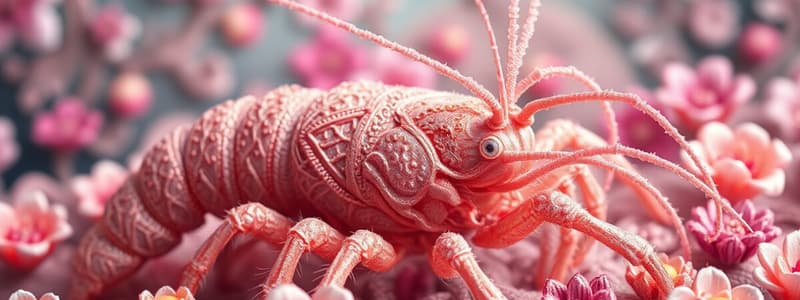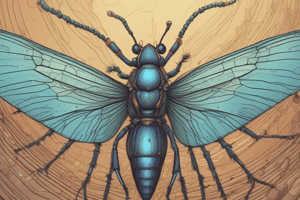Podcast
Questions and Answers
What is the origin of the name 'chitin'?
What is the origin of the name 'chitin'?
- Originates from the French word for 'covering' (correct)
- Derived from a Latin term meaning 'shell'
- Named after a novel protein in crustaceans
- Based on an ancient Greek term for 'skin'
Which of the following organisms is NOT mentioned as having chitin?
Which of the following organisms is NOT mentioned as having chitin?
- Moss (correct)
- Fungi
- Mollusks
- Arthropods
What is the primary structural feature that differentiates the allomorphs of chitin?
What is the primary structural feature that differentiates the allomorphs of chitin?
- Type of organism producing it
- Chemical composition
- Degree of hydration (correct)
- Color of the biopolymer
What is the most abundant allomorph of chitin?
What is the most abundant allomorph of chitin?
How does the chitin content in cockroaches compare to that in grasshoppers?
How does the chitin content in cockroaches compare to that in grasshoppers?
In which structure is chitin NOT primarily found?
In which structure is chitin NOT primarily found?
What percentage of chitin content is commonly found in the dry weight of crustacean shells?
What percentage of chitin content is commonly found in the dry weight of crustacean shells?
Which scientist first extracted chitin from fungus, referring to it as 'fungine'?
Which scientist first extracted chitin from fungus, referring to it as 'fungine'?
Which characteristic primarily differentiates the allomorphs of chitin?
Which characteristic primarily differentiates the allomorphs of chitin?
What is the significance of chitin's abundance in nature?
What is the significance of chitin's abundance in nature?
How does the degree of hydration relate to the stability of chitin's allomorphs?
How does the degree of hydration relate to the stability of chitin's allomorphs?
Which of the following roles does chitin primarily serve in organisms?
Which of the following roles does chitin primarily serve in organisms?
In which organism is the chitin content typically the highest, based on the data provided?
In which organism is the chitin content typically the highest, based on the data provided?
What is the primary chemical transformation that produces chitosan from chitin?
What is the primary chemical transformation that produces chitosan from chitin?
Which of the following statements about chitin is correct?
Which of the following statements about chitin is correct?
What major characteristic differentiates a-chitin from other allomorphs?
What major characteristic differentiates a-chitin from other allomorphs?
What distinguishes the three allomorphs of chitin?
What distinguishes the three allomorphs of chitin?
Which statement accurately reflects the thermal stability of a-chitin?
Which statement accurately reflects the thermal stability of a-chitin?
What is the role of chitin in the structure of fungi?
What is the role of chitin in the structure of fungi?
In terms of chitin content by dry weight, how does the chitin in house crickets compare to that in grasshoppers?
In terms of chitin content by dry weight, how does the chitin in house crickets compare to that in grasshoppers?
What is the significance of chitin being the second most abundant natural biopolymer?
What is the significance of chitin being the second most abundant natural biopolymer?
What provides the distinct characteristic of chitin being classified as a mucopolysaccharide?
What provides the distinct characteristic of chitin being classified as a mucopolysaccharide?
Which of the following properties is a function of the crystalline microfibrils of chitin in nature?
Which of the following properties is a function of the crystalline microfibrils of chitin in nature?
What distinguishes the content of chitin in insect cuticles from that in crustacean shells?
What distinguishes the content of chitin in insect cuticles from that in crustacean shells?
What factor primarily contributes to the high thermodynamical stability of a-chitin?
What factor primarily contributes to the high thermodynamical stability of a-chitin?
In which of the following organisms is chitin found as a key structural component, based on its role?
In which of the following organisms is chitin found as a key structural component, based on its role?
What is the primary reason chitin is considered the second most abundant biopolymer in nature?
What is the primary reason chitin is considered the second most abundant biopolymer in nature?
Which characteristic is common to all allomorphs of chitin?
Which characteristic is common to all allomorphs of chitin?
Which aspect primarily differentiates the three allomorphs of chitin?
Which aspect primarily differentiates the three allomorphs of chitin?
What is the relationship between chitin and chitosan in terms of chemical modification?
What is the relationship between chitin and chitosan in terms of chemical modification?
Which of the following statements about the discovery of chitin is true?
Which of the following statements about the discovery of chitin is true?
Which statement regarding chitin's distribution is accurate?
Which statement regarding chitin's distribution is accurate?
Flashcards are hidden until you start studying
Study Notes
Chitin Structure and Properties
- Chitin is a naturally occurring mucopolysaccharide, extracted from fungi by Henri Braconnot in 1811 and called “fungine”.
- In 1823, Auguste Odier found the same material in insects and called it chitin from the Greek word “chiton” meaning “covering”.
- Chitin is the second most abundant natural biopolymer after cellulose.
- Chitin is found in the exoskeletons of arthropods, cell walls of fungi and yeast, teeth of the radula, and shells of mollusks.
- There are three allomorphs of chitin: a, b, and g, differentiated by hydration, unit cell size and orientation.
- a-chitin is the most abundant and has high thermodynamical stability.
- Chitin content in dry weight is: 15%e30% in crustacean shells, 4%e11% in grasshoppers, 1%e2% in house crickets, 38% in cockroaches, 10%e30% in filamentous fungal cell walls, and 1e2% in yeast cell walls.
Chitin: Structure and Properties
- Chitin is a naturally occurring mucopolysaccharide found in various organisms.
- It was first discovered in 1811 by Henri Braconnot as "fungine" in mushroom cell walls.
- Identified in 1823 by Auguste Odier in insect cuticles.
- Chitin is the second most abundant natural biopolymer after cellulose.
- Found in the outer layers of crustaceans, insects, fungi, and fish.
- Occurs as crystalline microfibrils in the exoskeleton of arthropods.
- Its significant constituent in the cell walls of fungi and yeast.
- Present in the teeth of radula, calcified layers of mollusk shells, and pen of squids.
- Chitin content varies based on the organism, with crustacean shells containing 15-30% by dry weight.
- Three allomorphs of chitin: α, β, and γ.
- Allomorphs differ by hydration degree, size of unit cell, number of chains per unit cell, and orientation of microfibrils.
- α-chitin is the most abundant allomorph, exhibiting high thermodynamical stability.
Chitin
- Chitin is a natural mucopolysaccharide.
- Discovered in 1811 by Henri Braconnot, originally named "fungine".
- Auguste Odier later renamed it "chitin" in 1823.
- Found in outer layers of organisms like crustaceans, insects, fungi, and fish.
- Second most abundant natural biopolymer after cellulose.
- Exists as crystalline microfibrils.
- Found in structural components of exoskeletons in arthropods, cell walls in fungi and yeast, teeth of radula, calcified layers of mollusk shells, and gladii (pen) of squids.
- Chitin content varies by dry weight:
- Crustacean shells: 15% - 30%
- Grasshoppers: 4% - 11%
- House crickets: 1% - 2%
- Cockroaches: ~38%
- Filamentous fungal cell wall: 10% - 30%
- Yeast cell wall: 1% - 2%
- Three allomorphs of chitin: α, β, and γ.
- Degree of hydration, size of unit cell, number of chains per unit cell, and orientation of microfibrils differentiate the chitin allomorphs.
- α-chitin is the most abundant and thermodynamically stable.
Chitin
- Chitin is a naturally occurring mucopolysaccharide.
- Chitin was first discovered by Henri Braconnot in 1811.
- Chitin was called "fungine" before its name was changed by Auguste Odier in 1823.
- Chitin is found in the exoskeletons of crustaceans, insects and other organisms including fungi.
- Chitin is the second most abundant natural biopolymer.
- Chitin can be found in the form of crystalline microfibrils.
- Three allomorphs of chitin exist: a, b, and g.
- a-chitin is the most abundant allomorph and is thermodynamically stable.
Chitin Content by Dry Weight
- Crustacean Shells: 15% - 30%
- Grasshoppers: 4% - 11%
- House Crickets: 1% - 2%
- Cockroaches: 38%
- Filamentous Fungal Cell Wall: 10% - 30%
- Yeast Cell Wall: 1% - 2%
Studying That Suits You
Use AI to generate personalized quizzes and flashcards to suit your learning preferences.




